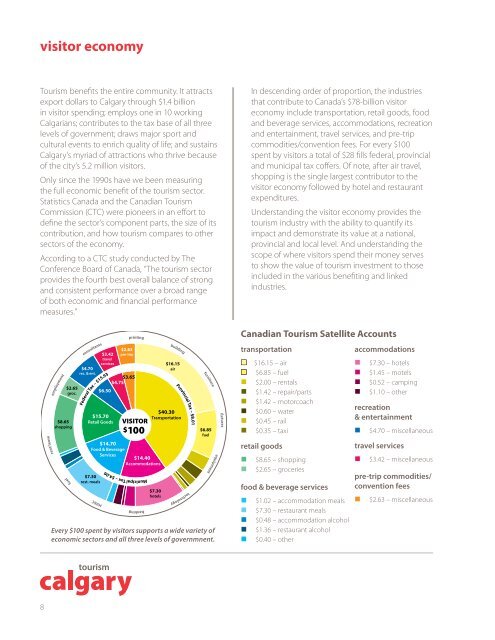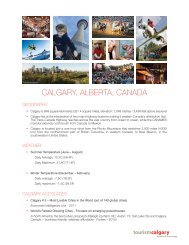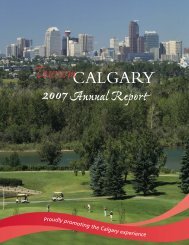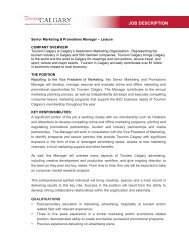strategic plan 2013-2015 - Tourism Calgary
strategic plan 2013-2015 - Tourism Calgary
strategic plan 2013-2015 - Tourism Calgary
You also want an ePaper? Increase the reach of your titles
YUMPU automatically turns print PDFs into web optimized ePapers that Google loves.
visitor economy<br />
<strong>Tourism</strong> benefits the entire community. It attracts<br />
export dollars to <strong>Calgary</strong> through $1.4 billion<br />
in visitor spending; employs one in 10 working<br />
Calgarians; contributes to the tax base of all three<br />
levels of government; draws major sport and<br />
cultural events to enrich quality of life; and sustains<br />
<strong>Calgary</strong>’s myriad of attractions who thrive because<br />
of the city’s 5.2 million visitors.<br />
Only since the 1990s have we been measuring<br />
the full economic benefit of the tourism sector.<br />
Statistics Canada and the Canadian <strong>Tourism</strong><br />
Commission (CTC) were pioneers in an effort to<br />
define the sector’s component parts, the size of its<br />
contribution, and how tourism compares to other<br />
sectors of the economy.<br />
According to a CTC study conducted by The<br />
Conference Board of Canada, “The tourism sector<br />
provides the fourth best overall balance of strong<br />
and consistent performance over a broad range<br />
of both economic and financial performance<br />
measures.”<br />
Every $100 spent by visitors supports a wide variety of<br />
economic sectors and all three levels of governmnent.<br />
In descending order of proportion, the industries<br />
that contribute to Canada’s $78-billion visitor<br />
economy include transportation, retail goods, food<br />
and beverage services, accommodations, recreation<br />
and entertainment, travel services, and pre-trip<br />
commodities/convention fees. For every $100<br />
spent by visitors a total of $28 fills federal, provincial<br />
and municipal tax coffers. Of note, after air travel,<br />
shopping is the single largest contributor to the<br />
visitor economy followed by hotel and restaurant<br />
expenditures.<br />
Understanding the visitor economy provides the<br />
tourism industry with the ability to quantify its<br />
impact and demonstrate its value at a national,<br />
provincial and local level. And understanding the<br />
scope of where visitors spend their money serves<br />
to show the value of tourism investment to those<br />
included in the various benefiting and linked<br />
industries.<br />
Canadian <strong>Tourism</strong> Satellite Accounts<br />
transportation<br />
• $16.15 – air<br />
• $6.85 – fuel<br />
• $2.00 – rentals<br />
• $1.42 – repair/parts<br />
• $1.42 – motorcoach<br />
• $0.60 – water<br />
• $0.45 – rail<br />
• $0.35 – taxi<br />
retail goods<br />
• $8.65 – shopping<br />
• $2.65 – groceries<br />
accommodations<br />
• $7.30 – hotels<br />
• $1.45 – motels<br />
• $0.52 – camping<br />
• $1.10 – other<br />
recreation<br />
& entertainment<br />
• $4.70 – miscellaneous<br />
travel services<br />
• $3.42 – miscellaneous<br />
pre-trip commodities/<br />
convention fees<br />
food & beverage services<br />
• $1.02 – accommodation meals • $2.63 – miscellaneous<br />
• $7.30 – restaurant meals<br />
• $0.48 – accommodation alcohol<br />
• $1.36 – restaurant alcohol<br />
• $0.40 – other<br />
8






![Download a Sample PDF [5.1 MB] - Tourism Calgary](https://img.yumpu.com/43603116/1/190x143/download-a-sample-pdf-51-mb-tourism-calgary.jpg?quality=85)






